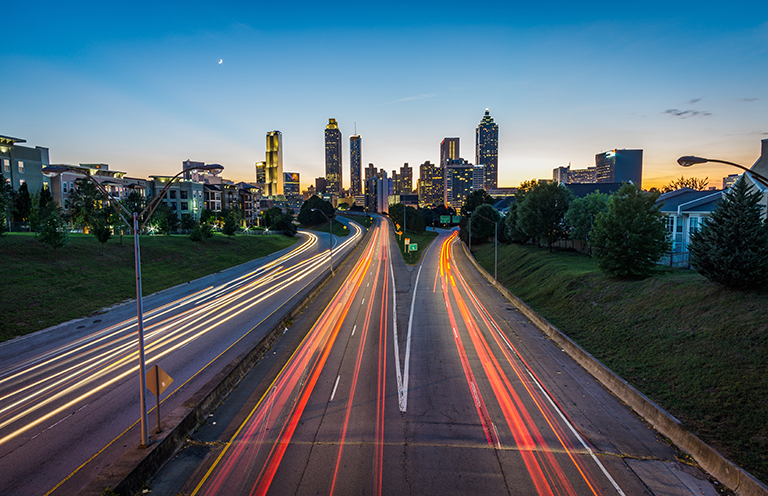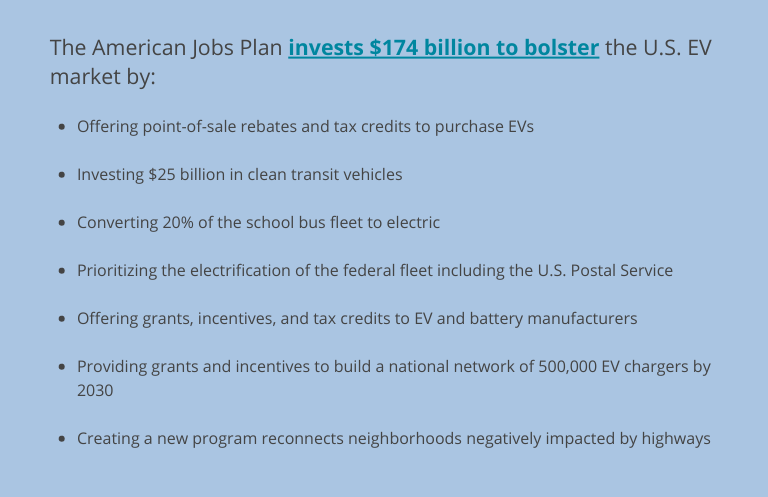All the places we’ll go – clean cars, trucks, buses, and jobs!

Anne Blair

America loves to drive. There are nearly 280 million vehicles on the road and the average person drives around 13,500 miles a year. The demand for transportation accounts for $1.9 trillion, or 9.1% of the GDP. We spend more money on transportation than we do on education ($1.4 trillion [6.5%]) and nearly as much as we do on food ($2 trillion [9.4%]). Our car-loving culture and transit-driven economy comes at a price beyond what we spend on vehicles and the gas that powers them. Our current system’s focus on personal, internal-combustion engine vehicles for every American was fueled by the creation of the interstate highway system in the 1950s and ‘60s. That sweeping infrastructure investment came at the expense of downtown, majority Black communities, and reliable mass transit systems in most American cities. Currently, just 3% of the trips Americans take are by mass transit.
Transportation is also the largest source of greenhouse gas emissions in the United States. Those emissions contribute to a warmer climate, higher rates of heat-related and respiratory illness, more severe weather, and sea level rise among other things. These factors increase the cost of healthcare, insurance, and housing. In the Southeast, the impacts of climate change are more disproportionately felt in low-income and Black communities. These neighborhoods are often bordered by transit corridors and lag in green infrastructure compared to wealthier or white counterparts.
Even accounting for emissions created by generating electricity, plug-in electric vehicles (EVs) are still three times cleaner than comparable gasoline-powered vehicles. However, there are only 1.8 million EVs currently registered in the U.S., representing less than 2% of all vehicles on the road. The U.S. market share of EVs is a fraction of the Chinese market and China has eight times as many charging points for EVs than America. With strategic investment, the U.S. has an opportunity to lead in EV manufacturing, infrastructure, drive down the price of EVs, increase demand, and create jobs.

The American Jobs Plan proposes expanding availability and access to energy efficient transportation by investing in a strong domestic supply chain for EVs and parts, growing the market for EVs, building a national network of charging infrastructure, creating an equitable and modern public transit system, and reconnecting communities that were purposefully divided by highway projects.
In the Southeast, EVs are revitalizing existing manufacturing infrastructure by adapting operations, or inviting new business. Blue Bird is making electric school buses in Fort Valley, GA; SK Innovation is building two battery facilities and just announced a joint venture with Ford Motor; Mercedes-Benz announced its Tuscaloosa County plant will start producing electric SUVs in 2022; Schnellecke Logistics Alabama is adding a new warehouse and jobs to support Mercedes-Benz; in Spring Hill, TN, GM is transitioning its existing plant to build electric vehicles and recently announced Ultium Cells LLC, a joint battery cell venture with LG Energy Solution; battery maker Microvast is building a new factory in Clarksville, TN; Sese Industrial Services is adding a new plant to their operations in Chattanooga, TN to make axle components for the Volkswagen EV line; and in the Carolinas, Arrival is building a headquarters and two microfactories to produce electric delivery vans.
The increase in EV production, in response to growing sales, requires charging infrastructure to match consumer demand. In addition to the upfront cost, range anxiety remains one of the top reasons people and businesses are hesitant about switching to EVs. Federal efforts, like the Department of Transportation’s intention to build charging infrastructure throughout the National Highway System provide a solid start to the transition away from fossil fuels towards a more efficient, and cleaner transportation future.
The American Jobs Plan breaks with precedent not only by not encouraging any expansion of the existing road network, but alternately proposing more modern and affordable public transit and rail, road safety measures for pedestrians, and reconnecting neighborhoods historically harmed by highway projects. A more reliable and resilient energy infrastructure that supports electrification also will decrease emissions in communities disproportionately impacted by transportation pollution while also reducing our sensitivity to market volatility, offers new opportunities in utility services, and provides storage capacity for renewable energy that can keep people safe in the face of disaster.
The powerful combination of consumer demand alongside federal policy focused on electric transportation has the potential to transform our communities into healthy places to live and work, gives us more efficient ways to connect with one another and in more ways, and lays a foundation for healthier communities for all residents in the Southeast and nationally.

